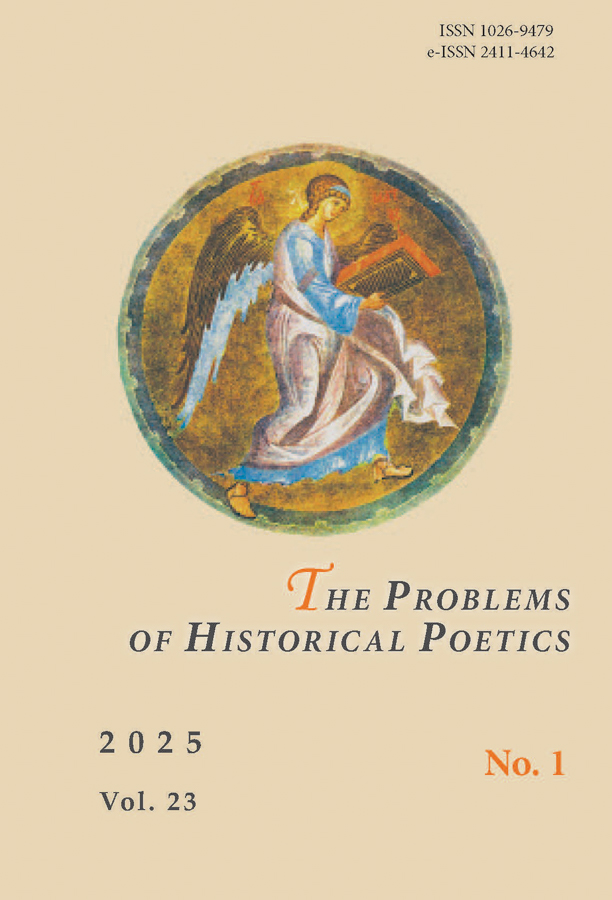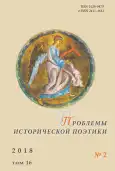The Archetypal Image of the Bird in the Tales of the Kola Sami (in the Records of the 19th–20th Centuries)
- Authors: Bakula V.B.1
-
Affiliations:
- Murmansk Arctic State University
- Issue: Vol 16, No 2 (2018)
- Pages: 18-35
- Section: Articles
- URL: https://journal-vniispk.ru/1026-9479/article/view/295305
- DOI: https://doi.org/10.15393/j9.art.2018.5221
- ID: 295305
Cite item
Full Text
Abstract
The images of animals in Sami folklore remain beyond the scope of research interest, meanwhile they are part of the pagan conception of the northern people about the surrounding world. The purpose of our study is to find out mythological representations of an ethnos that underlie the fairy-tale image of a bird and the further development of its semantics. The material for the study were the excerpts of the Sami myth about the world creation in which the sacral image of a waterfowl plays a major role, along with the collections of Sami fairy tales. The semantics of the image from its mythological up to its folkloric meaning was traced. The episodes of the Sami cosmogonic myth reveal traits of Finno-Ugric (the emergence of the world from the eggs of the bird) and praural (the demiurge is a waterfowl) views. The folkloristic image of the bird is based on mythological ideas of the ethnos about it as a demiurge, the bird is a mediator between heaven and earth, marital relations between birds and people reflect the totemic beliefs of the ancient Sami. A mythological image of the bird expands its semantics in fairy tales, where the bird becomes an assistant of people and participates in deciding on their destiny. Along with the mythological images of ducks, doves, ravens in fairy tales there are images of a goose, a swan, an eagle, a sea-gull, a dove, a falcon. All birds in folklore are related to the motif of werewolves.
About the authors
Victoria B. Bakula
Murmansk Arctic State University
Author for correspondence.
Email: museum-vs@yandex.ru
PhD in Philology, Associate Professor of the Department of Russian Philology and Mass Communications
Russian Federation, MurmanskReferences
- Anikin V. P. Russkoe ustnoe narodnoe tvorchestvo [Russian Oral Folk Art]. Moscow, Vysshaya shkola Publ., 2004. 735 p. (In Russ.)
- Bakula V. B. Dukhovnaya kul’tura saamov i ee otrazhenie v yazyke [The Spiritual Culture of the Sami and Its Reflection in the Language]. Murmansk, Print-2 Publ., 2017. 288 p. (In Russ.)
- Bakula V. B., Bezvesel’naya A. D. The National and Cultural Specificity of Sami Proverbs. In: V mire nauchnykh otkrytiy [In the World of Scientific Discoveries], 2013, no. 7 (43), pp. 356–370. (In Russ.)
- Belyaeva L. S. Saamskaya etnopedagogika [Sami Ethnopedagogy]. Murmansk, Murmansk State Pedagogical Institute Publ., 1991. 69 p. (In Russ.)
- Bodrova O. A. The Problems of Studying the Folklore of the Kola Sami. In: Trudy Kol’skogo nauchnogo tsentra Rossiyskoy akademii nauk [Proceedings of the Kola Science Center of the Russian Academy of Sciences]. Apatity, Kola Science Centre of the Russian Academy of Sciences Publ., 2016, no. 3 (37), pp. 116–122. (In Russ.)
- Bol’shakova N. P. Zhizn’, obychai i mify kol’skikh saamov v proshlom i nastoyashchem [Life, Customs and Myths of the Kola Sami in the Past and Present]. Murmansk, Murmanskoe knizhnoe izdatel’stvo Publ., 2005. 416 p. (In Russ.)
- Glukhova N. N., Glukhov V. A. Sistemy tsennostey finno-ugorskogo superetnosa: monografiya [The Value Systems of the Finno-Ugric Superethnos: Monograph]. Yoshkar-Ola, String Publ., 2009. 276 p. (In Russ.)
- Doroshin B. A. The Archetypal Image of the Demiurge Bird in the Mythological Beliefs of the Finno-Ugrians of the Volga Region: Some Anthropocosmic Aspects. In: Sociosfera, 2010, no. 4, pp. 156–160. (In Russ.)
- Ermolova A. About Sami Fairy Tales. In: Saamskie skazki [Sami Fairy Tales]. Murmansk, Murmanskoe knizhnoe izdatel’stvo Publ., 1959, pp. 3–10. (In Russ.)
- Zykov S. N. The Sacred Image of a Bird in the Objects of Finno-Ugric Themes. In: Fundamental’nye issledovaniya [Fundamental Research], 2014, no. 9, pp. 1876–1880. (In Russ.)
- Kitikov A. E. Poslovitsy i pogovorki finno-ugorskikh narodov [The Proverbs and Sayings of the Finno-Ugric Peoples]. Yoshkar-Ola, Mariyskoe knizhnoe izdatel’stvo Publ., 2004. 336 p. (In Russ.)
- Kulinchenko G. A. The Legend of Myandasha on the Stone. In: Saamskaya literatura: materialy i issledovaniya [Sami Literature: Materials and Researches]. Moscow, Literaturnaya Rossiya Publ., 2010, pp. 44–47. (In Russ.)
- Langinen A. V. The Mythology of the Finno-Ugric Peoples of Eurasia as a System of Meanings and Significances. In: Vestnik Chelyabinskogo gosudarstvennogo universiteta [Bulletin of Chelyabinsk State University], 2004, no. 1, pp. 36–41. (In Russ.)
- Lukina O. G, Lazutina Т. V. The Process of Transformation of the Image of a Bird (Loon) into a Symbol in the Art of the Peoples of the Russian North. In: Izvestiya Tomskogo politekhnicheskogo universiteta [Bulletin of the Tomsk Polytechnic University]. Tomsk, 2014, no. 6, pp. 89–95. (In Russ.)
- Meletinskiy E. Mif i istoricheskaya poetika fol’klora [The Myth and Historical Poetics of Folklore]. Available at: http://www.gumer.info/bibliotek_Buks/Literat/melet10/01.php (accessed on April 14, 2018). (In Russ.)
- Mechkina E. I. Fol’klornye traditsii v kul’ture saamskoy sem’i [Folklore Traditions in the Sami Family Culture]. Apatity, Kola Science Centre of the Russian Academy of Sciences Publ., 2010. 54 p. (In Russ.)
- Napol’skikh V. V. The Myth of Diving for the Land (A812) in Northern Eurasia and North America: Twenty Years Later. In: «Ne lyubopytstva radi, a poznaniya dlya…»: k 75-letiyu Yuriya Borisovicha Simchenko [«Not Just for the Sake of Curiosity, but for the Sake of Knowledge…»: on the Occasion of the 75th Birthday of Yuri Borisovich Simchenko]. Moscow, 2011, pp. 215–272. (In Russ.)
- Neklyudov S. Yu. Shapeshifting. In: Mify narodov mira: onlayn entsiklopediya [The Myths of the Peoples of the World: Online Encyclopedia]. Available at: http://www.mifinarodov.com/o/oborotnichestvo.html (accessed on April 14, 2018). (In Russ.)
- Patsiya E. Ya. Fairy Tales of the Sami of the Kola Region. In: Saamskie skazki [Sami Fairy Tales]. Murmansk, Murmanskoe knizhnoe izdatel’stvo Publ., 1980, pp. 4–10. (In Russ.)
- Petrukhin V. Ya. Mify finno-ugrov [The Myths of Finno-Ugrians]. Moscow, Astrel’ Publ., AST Publ., 2003. 464 p. (In Russ.)
- Peshkova V. S. The Images of Animals in Sami Proverbs and Sayings. In: Yazyk. Rech’. Kommunikatsiya: sbornik nauchnykh statey [Language. Speech. Communication: Collection of Scientific Articles]. Murmansk, Murmansk Arctic State University Publ., 2016, pp. 122–127. (In Russ.)
- Senkevich-Gudkova V. V. More on the Question of Transformation of the Sami Epos. In: Spetsifika fol’klornykh zhanrov [Specificity of Folklore Genres]. Moscow, Nauka Publ., 1973, pp. 246–255. (In Russ.)
- Sokolova Z. P. Kul’t zhivotnykh v religii [The Animals Worship in Religion]. Moscow, Nauka Publ., 1972. 216 p. (In Russ.)
- Telitsyna S. V. Poetika saamskogo fol’klora v obuchenii slovesnomu tvorchestvu detey doshkol’nogo vozrasta: dis. kand. filol. nauk [The Poetics of the Sami Folklore in Teaching of the Written Word of Preschool Children. PhD. philol. sci. diss.]. Available at: http://www.dissercat.com/content/poetika-saamskogo-folklora-v-obuchenii-slovesnomu-tvorchestvu-deteidoshkolnogo-vozrasta#ixzz2si2NjwNY (accessed on April 14, 2018). (In Russ.)
- Terebikhin N. M. Metafizika Severa: monografiya [The Metaphysics of the North: Monograph]. Arkhangelsk, M. V. Lomonosov Pomor State University Publ., 2004. 272 p. (In Russ.)
- Tokarev S. A. Rannie formy religii [Early Forms of Religion]. Moscow, Politizdat Publ., 1990. 622 p. (In Russ.)
- Kharuzin N. N. Russkie lopari (Ocherki proshlogo i sovremennogo byta) [Russian Lapps (Essays on the Past and Modern Life)]. Moscow, Vysochayshe utverzhdennoe Tovarishhestvo Skoropechatni A. A. Levenson Publ., 1890. 472 p. (In Russ.)
- Charnoluskiy V. V. V krayu letuchego kamnya [In the Region of the Flying Stone]. Moscow, Mysl’ Publ., 1972. 271 p. (In Russ.)
- Charnoluskiy V. V. Legenda ob olene-cheloveke [The Legend of the Deer-Man]. Moscow, Nauka Publ., 1965. 139 p. (In Russ.)
- Charnoluskiy V. V. About the Sami and Their Fairy Tales. In: Saamskie skazki [Sami Fairy Tales]. Moscow, Khudozhestvennaya literatura Publ., 1962, pp. 5–15. (In Russ.)
- Shokhova Yu. P. The Image of the Hero-Bogatyr in the Sami Fairy Tales. In: XIV Maslovskie chteniya: sbornik nauchnykh statey [The 14th Maslovsky Readings: Collection of Scientific Articles]. Murmansk, Murmansk Arctic State University Publ., 2017, pp. 135–139. (In Russ.)
- Shtyrlova V. O. Traditions of Russian Folklore in the Sami Fairy Tales. In: XV Maslovskie chteniya: sbornik nauchnykh statey [The 15th Maslovsky Readings: Collection of Scientific Articles]. Murmansk, Murmansk Arctic State University Publ., 2018, pp. 21–30. (In Russ.)
Supplementary files











